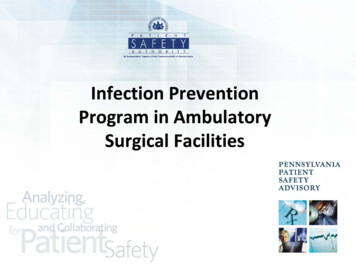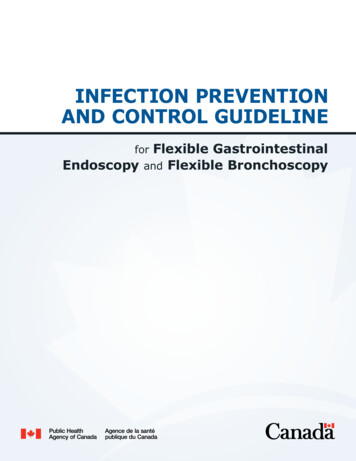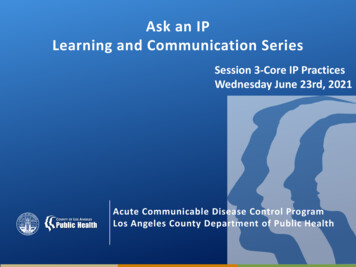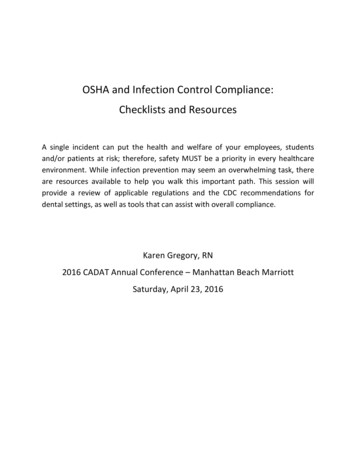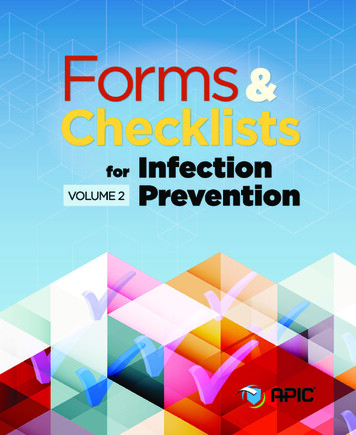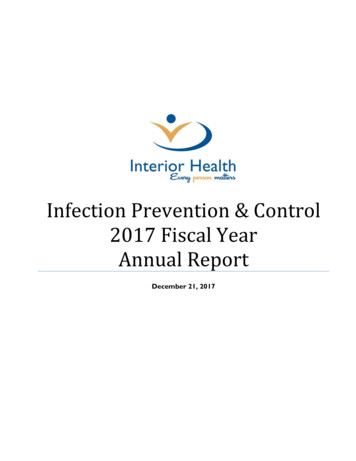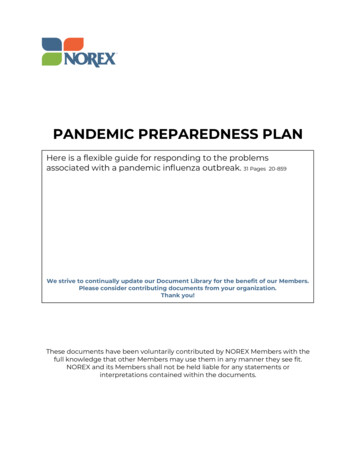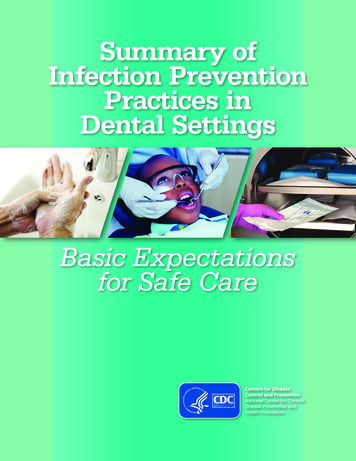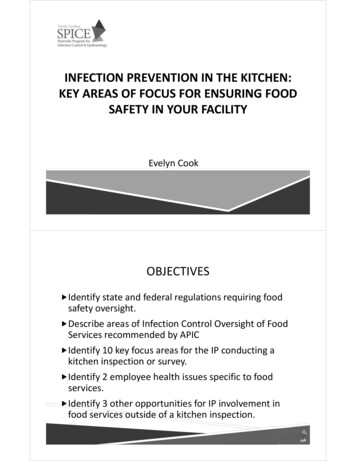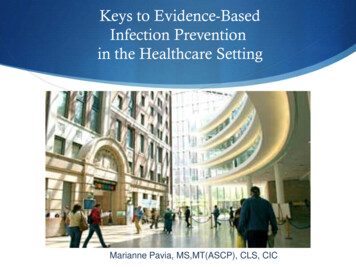
Transcription
Keys to Evidence-BasedInfection Preventionin the Healthcare SettingMarianne Pavia, MS,MT(ASCP), CLS, CIC
Disclosure This program is made possible by an education grant fromAbbott Diabetes Care Excelsior Medical
Learning Objectives Analyze the principles, practices and regulations associated with infection prevention in a health caresettingAnalyze the route of infection in the health care settingfrom its source to the susceptible hostDiscuss the evidence based methods to break the chainof infection and prevent transmission in the health caresettingClarify the role of point of care instrument disinfectionto prevent the spread of infectionDevelop creative strategies to adapt infectionprevention processes to a variety of settings
Infection Control Preventionist ICP The trained, competent ICP shall be able to establish anactive, effective, facility-wide program to help prevent thedevelopment and spread of infections and infectiousdiseases Prevent infection, not just control
The Importance of Prevention Study in California of healthcare-associated infection (HAI)rates:Only significant effector seen in lower rates of multidrugresistant infections was the presence of a certified infectionprevention director in the hospital.Pogotzeliska, M. et al 2012. Amer J Infection Control 40:96-101
Infection Prevention and Control Functions Surveillance Outbreak Control Isolation and Precautions Education Mandatory State Reporting Fiscal Responsibility Employee Health Antibiotic Stewardship Patient Safety Programs Hand Hygiene
SurveillanceCollecting data Review lab results Review charts Talk to stakeholders Tracking antibiotic usageData collection results in Outcome measures - # of infections Process measures- is equipment and supplies clean
Outbreak Control Most infections are sporadic A cluster (outbreak) implies the excess of the expectednumber Each disease has a different threshold: One case of flu One case of TB Three cases of MRSA
Antibiotic Stewardship Signs and symptoms of infection No cultures, start prophylactic treatment Virus but continue antimicrobials Results in: Antibiotic resistance No new drugs in development MRSA, VRE, MDRO, CRE
Regulatory StandardsFederalOccupationalSafety andHealthAdministrationCDCFDAStateDepartment ofHealthStateEducationDepartmentDepartment ofSanitationOthersTJCAPIC, SHEAAHAAORNCLIS
Professional ResponsibilityResponsibility to adhere to scientificallyaccepted principles and practices of infectionprevention and controlResponsibility to monitor those for whom theprofessional is responsible
The Chain of InfectionPathogenBiological agentcapableof causing diseaseSusceptible Hostlacks effectiveresistanceto pathogenReservoirwhere infectious agentnormallylives and multipliesMode ofPortal of Entryentry sites,mechanisms ofintroductionTransmissioncontact, droplet,airborne,common vehicle,vector-bornePortal of Exitmechanisms bywhichpathogen canleave reservoir
Breaking The Chain of InfectionPathogenXBiological agentcapableof causing diseaseSusceptible Hostlacks effectiveresistanceto pathogenReservoirwhere infectious agentnormallylives and multipliesXPortal of Entryentry sites,mechanisms ofintroductionXXMode ofXTransmissionPortal of Exitcontact, droplet,airborne,common vehicle,vector-borneXmechanisms bywhichpathogen canleave reservoir
Healthcare-Associated Infections HAIsOne HAI costs between 20,000- 40,000 per infectionIncreases the average length of stay by 19 daysCMS and VBP will not pay for HAIsCommitment to transforming the quality of healthcare byrealigning the healthcare facility’s financial incentives to do so.
Controlling The Route of Transmission ByBreaking the Chain of InfectionBasic Infection Control Practices Hand HygieneStandard PrecautionsTransmission - Based PrecautionsEngineering ControlsDisinfection of Patient Care EquipmentWork Practice Controls
Indirect Contact TransmissionTransfer of an infectious agent through a contaminatedintermediate object or person Hands of healthcare personnel Patient care devices (e.g., glucose meters) Instruments (e.g., endoscopes) that are not adequatelyreprocessed Medications and injection ines/Isolation2007.pdf
Importance of Hand HygieneHand contamination is a major cause of transmission of infection in healthcarefacilities.Improved hand hygiene is associated with lower rates of healthcare – associatedinfectionsAccording to the CDC, National adherence to recommended hand hygieneprocedures is POOR, from 5 – 81% with an overall average of 40%Hand hygiene is the most important infection prevention intervention.CDCTJC National Patient Safety Goal
The Joint CommissionNational Infection Control StandardsStandard IC.02.02.01The hospital reduces the risk of infections associated with medicalequipment, devices, and supplies (Most cited standard in 2011 36%)EP 1. Cleaning and disinfecting medical equipment, devices, andsuppliesEP2. Sterilizing medical equipment, devices, and supplies. (See alsoEC.02.04.03, EP 4)EP3. Disposing of medical equipment, devices, and supplies
Cleaning Patient Care EquipmentCritical ItemsEnters sterile tissue orvascular systemSemi-Critical ItemsTouches mucousmembranes or broken skinNon-Critical ItemsTouches intact skinExamples:Examples:Examples:Arthroscopes, surgicalinstruments, vascular devices,cardiac & urinary catheters,implants, dental instrumentsEndoscopes, laryngoscopes,SterilizationAutoclave / Liquid Sterilants(Cycle / Exposure time permanufacturer)diaphragm fitting rings, respiratoryand anesthesia equipment, vaginalultrasound probesHigh-Level DisinfectionOPA(exposure time 12 minutes)Stethoscopes, blood pressurecuffs, tabletops, bedpans, floorsand furnitureLow-LevelDisinfectionPDI super Sani-Cloth(exposure time 2 minutes)Clorox Wipes(exposure time 5 minutes)
Antiseptics vs. DisinfectantsAntiseptics are used on living tissues to protect thespreading of germs and infection to humans.Disinfectants are used on surfaces to disinfect itemswhich can potentially transmit germs.
Contact Times for Surface DisinfectantsEPA-registered disinfectantsLong contact time is not practical for disinfectionof environmental surfacesMost health-care facilities utilize a disinfectantwith a contact times of one to three minutesCDC Guideline for Disinfection and Sterilizationin Healthcare Facilities, 2008
WHAT GOES WHERE?CLEAN AND DIRTY CAN NEVER MIX!Dirty (examples) Waste receptacles Patient specimens Sharps containers Used linen Recycling Used instruments Dirty items should never be inclean storage areasClean (examples)Sterile packsSupplies of PPELinenIV pumps/poles (clean)Other clean medical equipmentand supplies Clean items should never be in dirty utility rooms
GlucometerManagement HBV can survive for at leastone week in dried blood onenvironmental surfaces or oncontaminated instrumentsand supplies.Hepatitis B Virus InfectionRisks among Diabetic PatientsResiding in Long-Term CareFacilities: 30 acute HBV infections and2 deaths shared equipment and lapsesin aseptic technique orinfection control practices.Clin Infect Dis. (2005) 41 (5): 760-761.doi:10.1086/432624
Hepatitis B VaccineHBV vaccination is a safe, effective means of prevention.Key criteria for HBV vaccination recommendation:Advisory Committee on Immunization Practices (ACIP) recommend adults aged 60 years w/diabetes be vaccinated for HBV.1Benefit of routine vaccination for adults aged 60 years is reduced as vaccine immunogenicityappears to decrease w/ increasing age.21.Centers for Disease Control and Prevention. Use of hepatitis B vaccination for adults with diabetes mellitus: Recommendations of theAdvisory Committee on Immunization Practices (ACIP). MMWR 2011;60:1709-11.2.Zimmerman RK, Middleton DB, Burns IT, Clover RD, Kimmel SR. Routine vaccines across the life span, 2007. J Fam Pract 2007;56:S18-37.
CDC Blood Glucose Meters Sharing of blood glucose meters should be avoided, ifpossible. If shared, the device must be cleaned anddisinfected after every use according to manufacturer’sinstructions. If there are no manufacturer’s instructions, the devicemust not be shared.11. CDC. Blood Glucose Monitoring Frequently Asked Questions (FAQs) regarding Assisted Blood GlucoseMonitoring and Insulin Administration. March 8, 2011 -monitoring faqs.html.
FDA: DisinfectionBlood glucose meters should be cleaned and disinfectedper manufacturer’s instructions after each and everyuse, unless assigned to a single patient and protected byspecific precautionsFDA guidance for manufacturers:“The disinfection solvent you choose should be effectiveagainst HIV, Hepatitis C, and Hepatitis B viruses . Pleasenote that 70% ethanol solutions are not effective against viralblood borne pathogens and the use of 10% bleach solutionsmay lead to physical degradation of your device.”11.FDA htm
Glucometer ManagementClean glucometer surface when visible blood or bloody fluids are present bywiping with a cloth dampened with soap and water to remove any visibleorganic material.If no visible organic material is present, disinfect after each use the exteriorsurfaces following the manufacturer’s directions using a cloth/wipe witheither an EPA-registered detergent/germicide with a HBV/HIV label claim.Remember the contact time needed for disinfection.
Test Strips Test strips packaged in vials can become contaminated withbacteria during routine use in the hospital Studies confirm that bacterial contamination of test strips fromopen vials is common, and suggest that these vials can serve asreservoirs for patient- to-patient transmission of potentiallypathogenic bacteria
CDC RecommendationCDC recommends:“Unused supplies and medications taken to a patient’sbedside during finger stick monitoring or insulinadministration should not be used for another patientbecause of possible inadvertent contamination.”11.Diabetes and Viral Hepatitis: Important Information on Glucose Monitoring, Centers for DiseaseControl: oring.htm.
Clinical Laboratory Standards Institute“ It is recommended that unused supplies taken to apatient’s bedside during fingerstick monitoringshould not used for another patient because ofpossible inadvertent contamination.”1. CLSI. Point-of-Care Blood Glucose Testing in Acute and Chronic Care Facilities; Approved Guideline; Third Edition. CLSIdocument POCT12-A3. Wayne, PA: Clinical and Laboratory Standards Institute 2013; 22:18.
Bacterial Contamination ofGlucose Test StripsA 2011 Letter to the Editor published in the AmericanJournal of Infection ControlInvestigate bacterial contamination of glucose test stripsin vials.Performed over 6 consecutive weeks in 4 wards of 400bed teaching hospital.148 test strips were collected and cultured for bacterialload.Strip contamination rate: 16.6% - 35.7%. Authors concluded the narrow strip vial openingrequires repeated manual touching to pull a stripout, under non-sterile conditions. Investigators’ recommendation:“Dispense singleunits that can be used in a ‘no-touch’procedure.” 1
Bacterial Contamination ofGlucose Test Strips
Bloody Contamination of Test Strips81 vials in active use, with 10 strips remaining, submitted by userswere blood-contaminated in 2 of 3 institutionsBlood contamination on outside (2) and inside (1) of vials confirmedby sensitive test methodologiesCan the vials be cleaned?Vial disinfection may expose unused test strips to bleach-based agents,add staff timeDisinfection will also adversely affect scanning of test vial and readingexpirations dates and lot numbersGeaghan SM, independent lab analysis sponsored by Abbott Diabetes Care
Questions for you Choose your response, click submit
Single-Use SuppliesIndividually packaged supplies for patient safety
Breaking the Chain of InfectionPathogenBiological agentcapableof causing diseaseSusceptible Hostlacks effectiveresistanceto pathogenReservoirwhere infectious agentnormallylives and multipliesMode ofPortal of Entryentry sites,mechanisms ofintroductionTransmissioncontact, droplet,airborne,common vehicle,vector-bornePortal of Exitmechanisms bywhichpathogen canleave reservoir
Spaulding Classification
SUMMARYWe can help reduce the risk of cross-contamination by: Using only single-use skin puncture/lancet devices Advocating for restricting point-of-care meter use to a singlepatient, when possible Properly cleaning and disinfecting meters according tomanufacturer’s recommendation Changing gloves and perform hand hygiene between patients foreach testing event Employ single-use packaging of glucose test strips Be an advocate and encourage others to break the chain ofinfection
Patient Safety“It may seem a strangeprinciple to enunciateas the very firstrequirement in ahospital that it shoulddo the sick no harm”.Florence Nightingale
CDC Guideline for environmental infection control in health-carefacilities: recommendations of CDC and the HealthcareInfection Control Practices Advisory Committee. MMWR,2003;52(No. RR-10):1-44. Centers for Disease Control and Prevention. Appendix A:Regulatory framework for disinfectants and sterilants. In:Guidelines for infection control in dental health-care settings- 2003. MMWR 2003;52(No. RR-17):62-64. Rutala, WA. APIC guideline for selection and use ofdisinfectants. Am J Infect Control 1996;24:313-42.
Additional References Guideline for environmental infection control in health-care facilities:recommendations of CDC and the Healthcare Infection ControlPractices Advisory Committee. MMWR, 2003;52(No. RR-10):1-44. Centers for Disease Control and Prevention. Appendix A: Regulatoryframework for disinfectants and sterilants. In: Guidelines for infectioncontrol in dental health-care settings - 2003. MMWR 2003;52(No. RR17):62-64. Rutala, WA. APIC guideline for selection and use of disinfectants. AmJ Infect Control 1996;24:313-42.
The trained, competent ICP shall be able to establish an active, effective, facility -wide program to help prevent the . Hand hygiene is the most important infection prevention intervention. CDC TJC National Patient Safety Goal . The Joint Commission National Infection Control Standards
